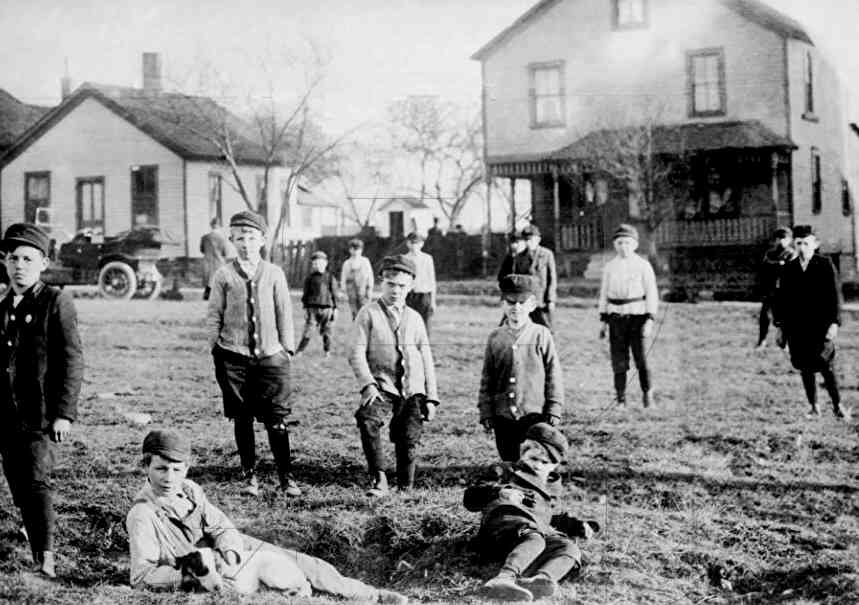We see boys wearing peaked caps with a wide range of outfits. Sometimes the same fabric was used for both the cap and outfit. Peaked caps were worn for both dress and casual wear, but the conventions here varied overtime. We note younger boys wearing with dressy outfits after the mid-19th century. We note boys wearing these caps with dresses, kilt suits, and Fauntleroy suits. There seems to have been no set conventions, but the style was just seen as fashinable, perhaps becuse it came from Britain. The cut of some of these 19th century peaked caps were a little differnt than the 20th century caps. Some private schools in the late-19th century adopted them as part of the school uniform. This seems to be where thy became more standardized. American boys did not commonly wear school uniforms. This was more common in Britain. By the late-1910s, peaked caps were generally replaced as casual wear by the flat cap. The flat cap was not adopted as a school uniform item. The peaked cap did not have a strong school association in America as was the case in Britain. The flat cap became the standard cap for American boys in the 1910s. The peaked cap, however, did not disaapear. It became more associated as a younger boys dress cap. They were often bought to match suits. The American Eton suit is especially associated with these caps, but they were not only worn with suits. The Boy Scout Association chose a peaked cap as the official headwear for the new Cub program (1930s). It was styled like the British Cub cap, but done in blue and gold.
Construction
Spme of the forst peaked caps we see after the mid-19th century were cut fullr nd looked a little different than the more standardized peaked cap worn in the 20th century. Many flat caps in the early 20th century were not real flat, looking somewhat like the peaked cap. We do see some boys earing these caps to school. They were more commonly worn by boys at private schools, some of which did have uniforms.
As far as we can tell, these peaked caps in America and Britain were not done with chin straps. TAt least we have not seen boys wearing them with chin straps. This incluses theCub and school variants. We have noted chin straps in Japan, but not in America. There was, however, a related American version. Some of these caps were one with ear flaps which buckled under the chin. The ear flaps tucked inside the cap
This woulkd have been a bother for a boy wearing the cap during the summer. This of course was for cold weather wear when these caps were worn with suits and winter coats. We think these caps were made in summer and winter versions. We are nor sure when the ear flaps first appeared. The early caps did not have ear flaps. We do not see them until the 20th century. We note one boys wearing hsi peaked cap and ear flps in 1948 with a pea jacket. We do not think that the caps were made with ear flaps after the 1960s. Hopefully we can develop the chronology in greater detail as HBC expands.
Age
The age range for peaked caps varied over time. We see school age boys up to the early-teens wearing them at the turn-of-the 20th century. This of course does not include variants like bicycle clubs and private school uniforms. With the popularity of the flat cap (1910s), we begin to see mostly younger boys wearing the caps, although there were no set rules. Boys to about 10=year of age wore hm to mid-entury, but since the 1960s it has ben mostly pre0sscjjol boys.
Gender
The peaked cap was strictly a style for boys. We never see girls wearing them. Gorls adopted some boy styles, but this was not one of them.
There may have been a upper-class association with these caps when they first appeared. They were initually a Britiosh import, but the caps were not widely worn in the 1880s abd early-90s. We see more boys wearing them in the late-1890s. We begin to see American boys wearing these caps in any number around the turn-of-the 20th century, By this time there does not seem to have been any social class connotations associated with them. The group of boys here is a good example. They look to be boys from fairly average circumstances (figure 1). We note a lot of images of working boys wearing these caps along with other styles in the 1900s and early-1910s. They were clearly worn by working-class boys. We also see boys from affluent families wearing them. This began to change in the 1910s, especially by the end of the decade. Most boys in the 1920s wore flat caps. Some boys continued wearing peaked caps, but most;y boys from more affluent families. A connectiin developed between peaked caps and short pants suits. The conbination was primarily worn by boys from conservative, well-to-do families. Briiish connections was a factor here. This is apparent in the photographic record. We can also see it in Hollywood. A good example here is "Annabel Takes a Tour" (1937). Anothervgood example is "Aunty Mame" (1958). The peaked cap with suits was a style most common with affluent families for several decades. It was considered stylish through the 1960s.
HBC

Navigate the Boys' Historical Clothing Web Site:
[Return to the Main U.S. cap style page]
[Return to the Main peaked cap page]
[Introduction]
[Activities]
[Biographies]
[Chronology]
[Clothing styles]
[Countries]
[Bibliographies]
[Contributions]
[FAQs]
[Glossary]
[Images]
[Links]
[Registration]
[Tools]
[Boys' Clothing Home]
Created: 12:44 AM 5/17/2009
Last updated: 5:33 PM 4/28/2014



